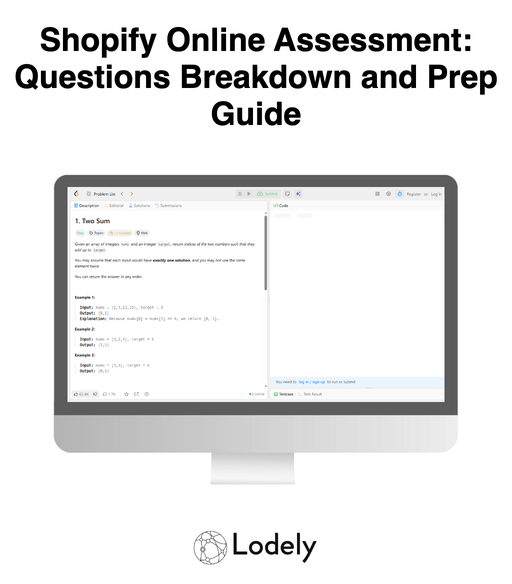Shopify Online Assessment: Questions Breakdown and Prep Guide
Thinking about “Cracking Shopify’s Assessment” but not sure what you’re getting into? You’re not alone. Engineers everywhere are staring down CodeSignal, HackerRank, timers, and e-commerce-flavored twists — and the hardest part is knowing what to train for.
If you want to walk into the Shopify Online Assessment (OA) confident and ready to ship, this guide is your playbook. No fluff. Real breakdowns. Strategic prep.
When to Expect the OA for Your Role
Shopify’s OA timing and content vary by role and level. Here’s the usual pattern:
- New Grad & Intern Positions – Expect an OA soon after initial recruiter contact. For internships, it’s often the primary technical screen before a final loop.
- Software Engineer (Backend / Full-Stack / Mobile) – Standard. Look for a CodeSignal or HackerRank link. Problems are data-structures-and-algorithms heavy, with occasional e-commerce context.
- Frontend Engineer – Mixed. Some candidates get algorithmic questions plus DOM/JS fundamentals or implementation tasks.
- Data / ML / Analytics – Often includes data manipulation, SQL-style logic, and algorithmic questions; sometimes a short practical data task.
- SRE / Platform / Infrastructure – Expect algorithmic coding with system-y nuances: rate limiting, caching, concurrency, or log parsing.
- Senior Engineering Roles – Some candidates skip a generic OA and go straight to live coding or a take-home/pairing session, but many still see a short OA as an initial filter.
- Non-Engineering Roles – Rare. When used, it’s usually analytics/logic rather than coding.
Action step: When your recruiter reaches out, ask, “What’s the expected format of the OA for this role?” You can usually get the platform, number of problems, and timing.
Does Your Online Assessment Matter?
Yes — more than you might think.
- It’s the main filter. Your resume gets you in; your OA performance moves you forward.
- It sets the tone. Interviewers may skim your OA code and shape follow-ups around it.
- It’s realistic. Shopify cares about correctness under pressure — think flash sales, high read/write, precision with money, and idempotency.
- It signals work style. Clean code, good naming, thoughtful edge cases, and complexity awareness all matter.
Pro Tip: Treat the OA like a first-round interview. Write readable code, explain assumptions in comments, and check edge cases.
Compiled List of Shopify OA Question Types
Candidates often report seeing problems like these. Practice them:
- Shopping Offers — type: DP / Backtracking (cart price optimization)
- Top K Frequent Elements — type: Heap / Hash Map (popular products)
- LRU Cache — type: Design / Hash + DLL (caching product/collection queries)
- Logger Rate Limiter or Design Hit Counter — type: Queue / Sliding Window (API throttling)
- Search Suggestions System — type: Trie / Sorting (typeahead for product names)
- Meeting Rooms II — type: Intervals / Heap (capacity or slot allocation analogs)
- Merge Intervals — type: Intervals / Sorting (delivery windows, discount ranges)
- Subarray Sum Equals K — type: Prefix Sum / Hashing (order totals / window checks)
- Product of Array Except Self — type: Array / Prefix-Suffix (careful with zeros, no division)
- Two Sum / Variants — type: Hash Map (bundle/discount pairing)
- K Closest Points to Origin — type: Heap / Geometry (closest warehouses/fulfillment centers by metric)
- Implement Trie (Prefix Tree) — type: Design / Strings (search and autocomplete)
- Binary Search on Answer: Koko Eating Bananas — type: Parametric Search (capacity planning)
- Validate Parentheses — type: Stack (string parsing fundamentals under time pressure)
How to Prepare and Pass the Shopify Online Assessment
Start thinking like a builder under load. You’re practicing speed, correctness, and clarity.
1. Assess Your Starting Point (Week 1)
Identify strengths (arrays, hashing, strings) and gaps (graphs, DP, heaps). Use LeetCode Explore or HackerRank warm-ups to baseline yourself. This tells you where to invest your time.
2. Pick a Structured Learning Path (Weeks 2-6)
You have options:
- Self-study on LeetCode/HackerRank
- Best if you’re disciplined. Focus on arrays, maps, heaps, sliding window, intervals, and classic design questions (LRU, rate limiter).
- Mock assessments / bootcamps
- Timed, proctored runs that mirror CodeSignal/HackerRank pacing and pressure.
- Career coach or mentor
- A software engineer career coach can review your code, simulate OAs, and push you on time management.
3. Practice With Realistic Problems (Weeks 3-8)
Create a list of 40–60 Shopify-style problems. Use a timer. After solving, refactor for readability and add assertions for edge cases: empty carts, zero inventory, float/decimal precision, duplicated SKUs.
4. Learn Shopify-Specific Patterns
Expect e-commerce flavored logic:
- Cart price rules and discounts (stacking, exclusions, thresholds)
- Inventory reservation and idempotency for checkout
- Rate limits and caching (storefront/Admin APIs; burst handling)
- Pagination and cursors (GraphQL-style patterns)
- Currency/money precision (integers or fixed-point, avoid float errors)
- Time zones and order windows (interval merging and comparisons)
5. Simulate the OA Environment
Use CodeSignal practice or HackerRank sample tests. Give yourself the exact duration (often 75–90 minutes for 2–3 questions). Disable distractions, keep one language, and practice copy/paste hygiene and fast input parsing.
6. Get Feedback and Iterate
Review solutions a day later. Ask: Did I miss an edge case? Could my complexity be better? Are variable names clear? Share with a peer/mentor and track your repeated mistakes.
Shopify Interview Question Breakdown

Here are featured sample problems that mirror Shopify-style OA thinking. Nail these patterns and you’ll cover most of the ground.
1. Cart Price Optimization With Offers
- Type: DP / Backtracking
- Prompt: You’re given item prices, quantities, and bundle offers. Compute the minimum total price to fulfill a cart.
- Trick: Use DFS with memoization over remaining needs; prune when offers don’t help. Represent cart state as a tuple to cache.
- What It Tests: State modeling, pruning, DP intuition, and handling complex pricing rules.
2. Inventory Reservation Across Warehouses
- Type: Greedy / Heap / Sorting
- Prompt: Given order quantities and multiple warehouses with stock and shipping cost, fulfill the order with minimal cost while respecting stock limits.
- Trick: Sort by cost or use a min-heap; subtract greedily while tracking remaining demand. Watch for partial fills and zero-stock warehouses.
- What It Tests: Greedy design, heap usage, and edge cases (insufficient stock, ties, zero-cost).
3. API Rate Limiter (Sliding Window)
- Type: Queue / Sliding Window / Design
- Prompt: Implement a per-user request limiter that allows N requests per rolling T milliseconds.
- Trick: Use a deque of timestamps per key; evict old entries; check size before accepting. For high scale, consider bucketing time or approximate counting.
- What It Tests: Sliding window mechanics, time-based eviction, and pragmatic API safeguards.
4. Search Suggestions for Product Titles
- Type: Trie / Sorting / Binary Search
- Prompt: Given a list of product names and a query typed character by character, return up to K lexicographically smallest suggestions per prefix.
- Trick: Pre-sort and use binary search to find prefix range, or build a Trie with capped suggestion lists to keep memory/time low.
- What It Tests: Prefix indexing, string handling, and memory-aware design choices.
5. Top K Trending SKUs
- Type: Heap / Hash Map / Streaming
- Prompt: From a stream of product views or purchases, return the top K SKUs at any point.
- Trick: Maintain frequency map plus a min-heap of size K; update counts incrementally. For very large streams, consider approximate structures.
- What It Tests: Heap mastery, streaming updates, and space/time trade-offs.
What Comes After the Online Assessment

Passing the Shopify OA is the entry ticket. From here, it’s about how you build, communicate, and collaborate.
1. Recruiter Debrief & Scheduling
You’ll get an email with next steps. Ask about upcoming rounds, interview format (pairing vs. problem solving), and any prep tips. Confirm your preferred language and tooling for live sessions.
2. Live Technical Interviews
Expect interactive coding on a shared editor or CodePair. You may:
- Solve DS&A problems similar to the OA (but with guidance).
- Debug or extend an existing function.
- Talk through trade-offs and edge cases out loud.
Pro tip: Review your OA code. Interviewers may reference it.
3. Pair Programming on a Realistic Feature
Shopify commonly uses pairing to see how you work. You might build or refactor a small feature, write tests, or improve performance in an existing snippet (often web/backend flavored). They’re assessing collaboration, clarity, and iterative delivery.
4. System Design / Architecture Round
For mid-level and senior roles, you’ll design something like:
- A checkout flow with inventory reservation and idempotency
- A storefront search with caching and pagination
- A rate-limited API with observability and fallbacks
They’re looking for scale thinking, failure modes, data modeling, and pragmatic trade-offs.
5. Behavioral & Values (“Life Story” Style)
Expect deep dives into how you work:
- Merchant obsession: how you translate ambiguous requirements into outcomes
- Ownership and autonomy under changing priorities
- Collaboration across product/design with clear communication
Use the STAR method and tie examples to impact and learning.
6. Final Round / Onsite Loop
A multi-interview block that may include:
- Another coding or pairing session
- A design or architecture deep dive
- Cross-functional conversations with product or leadership
Manage your energy, ask clarifying questions, and keep solutions simple and shippable.
7. Offer & Negotiation
If it’s a match, you’ll get a verbal, then a written offer. Compensation typically includes base and equity. Benchmark ranges and negotiate thoughtfully.
Conclusion
You don’t need to guess — you need a plan. The Shopify OA is challenging but predictable. If you:
- Identify weak areas early,
- Drill Shopify-style problems under timed conditions,
- Write clean, edge-case-aware code,
you’ll turn the OA into momentum for the rest of the process. You don’t need to be a Shopify expert — but you do need strong problem-solving and a builder’s mindset. Treat the OA like your first interview, and you’ll give yourself the best shot at the offer.
For more practical insights and prep strategies, explore the Lodely Blog or start from Lodely’s homepage to find guides and career resources tailored to software engineers.






%2C%20Color%3DOriginal.png)



